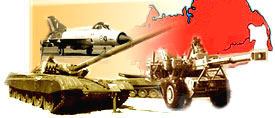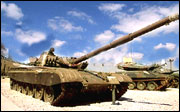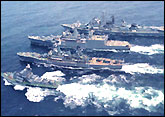The Rediff Special/ Josy Joseph


How a nation was looted
The plunder of Indian forces by arms dealers was at its peak in the early 90s, soon after the collapse of Soviet Russia.
Till then, Russia was India's key supplier of all military wares. Most of the Indian Air Force planes including a series of MiGs, helicopters and other weapons systems, the Army's T-72 tanks and many guns, and a large number of the Navy's ships were Russian-made.
And when Russia crumbled, the Indian armed forces faced a crisis. Which was when shrewd middlemen stepped in.
They employed every possible means to exploit India's vulnerability. Officials of the three forces will tell you how arms dealers then went on a looting spree and Delhi's confused defence establishment gave in to them.

Till the early 80s it was believed that armaments were the money-spinners. But when countries like Britain began to trim their navy, spare parts too became lucrative. Now it is believed the profit from spare parts is far more than that from armaments.
After Soviet Russia's collapse, the IAF desperately wanted some spares for the MiG-29s. There were none available, except with a Gulf-based firm. It named an exorbitant price, to which the IAF had to agree.
"Indigenisation was very limited in our country. Most of these sophisticated spares had to come from outside," admit a senior IAF officer.
Soon attempts were made to clean up the mess. The then joint secretary, air force, Vinod Rai sent delegations to Russia to identify original manufacturers.
"We were highly successful. If not for that officer's vision, the IAF would have been fleeced of several millions more," says a serving officer who was part of the exercise.
In the Navy, the role of middlemen -- known as 'ship chandlers' -- are mostly documented. After Russian manufacturers became unavailable, an organised and well-connected clutch of firms took over as suppliers. Among them, Makalu Corporation, Machinery Sales Corporation, HC Supplies and Dynatron.
Their entry was sanctified through "open tenders", which were against existing rules. Most of the companies had several retired officers running the show.
In fact, Makalu, which figured prominently in the Vishnu Bhagwat controversy, was started by a retired naval officer. Despite being blacklisted, Makalu concluded a deal with the Russian company A O Compressor for supplying compressors for the Navy's Charlie class vessels.
Vice-Admiral Harinder Singh, whose transfer was the key reason behind Admiral Bhagwat's dismissal, had enjoyed the hospitality of the Makalu Corporation in 1997 in Moscow. He said he had informed the naval headquarters about it -- but the fact remains that Makalu was by then on the blacklist.
Makalu Corporation, the Central Bureau of Investigation confirmed during an inquiry in 1998-99, was paying several naval officers and their relatives through banks in countries like Switzerland and Hungary.
Its influence can be gauged from the fact that once the Russian government agency, Spetsvneshteknika, refused spares to India saying Makalu had been given "exceptional rights for delivery to India".
Realising the heavy price being paid to middlemen, the Navy sent logistical delegations directly to the manufacturers. The LOGDELs, as they are known in naval parlance, negotiated directly and saved India millions.
However, there are several instances when, despite such delegations, orders were placed with ship chandlers. And it is alleged that this axis, which had the blessings of some civilian officials, worked against Rear Admiral Suhas V Purohit when his promotion came up in 1997-98.
In fact, Admiral Purohit had put on record in 1995 a note about ship chandlers: "As a general rule, ship chandlers prices are very high. The minimum mark-up is around 50% and maximum in the multiple of OEMs (original equipment manufacturers) prices."
In April 1997, a board of inquiry in the Eastern Naval Command recorded the massive profits that such firms were making. However, no action was taken against the officials the inquiry named.
A comparative price chart tells the story:
| Item |
Logdel price |
Ship Chandler |
| D(408)B Crystal |
Rs 35 |
Rs 17,805 |
| Relay PEC-9 |
Rs 95 |
Rs 11,192 |
| Lower Cover |
Rs 1,475 |
Rs 38,725 |
| Balancing piston |
Rs 1,475 |
Rs 46,750 |
In an annexure to his court petition, Admiral Purohit says that most of these purchases were "unnecessary", as stocks existed.
Though the naval delegation to Russia had identified several original equipment manufacturers, several purchases continued through middlemen. Spares worth Rs 680 million was bought to service a set of pumps worth just Rs 200,000, points out Admiral Purohit.
Arms firms began sprouting in India in the late 70s, taking advantage of the loopholes in the law.
For example, the Navy had a rule that said spares and equipment can be obtained from commercial sources, who in effect are middlemen.

Sonar 184 M on Himgiri ship was bought from a commercial source, which had no previous experience in the trade. Later, when INS Nilgiri, of the same class, came up for sonar fitting, some intelligent naval officers approached the original manufacturer, Graesby Ltd, and saved 50,000 pounds on that single purchase. This is noted in a naval study during 1978-87.
When NATO forces began to cut down their naval forces, it led to an immediate surplus capacity in manufacturing bases in the West and a surplus of spares in the market. Shrewd men jumped in, procured these at very cheap rates, and began selling to the Indian Navy at exorbitant prices
There are more such cases, and a few prominent players. If the defence dealings are analysed in detail, a handful of names will emerge as the ones who control India's arms purchases.
They are well-known, but hardly ever named.
ALSO SEE:
The infamous case of INS Shakti
The HDW-Bofors sagas
Return to How a nation was looted
Design: Lynette Menezes
The Rediff Specials